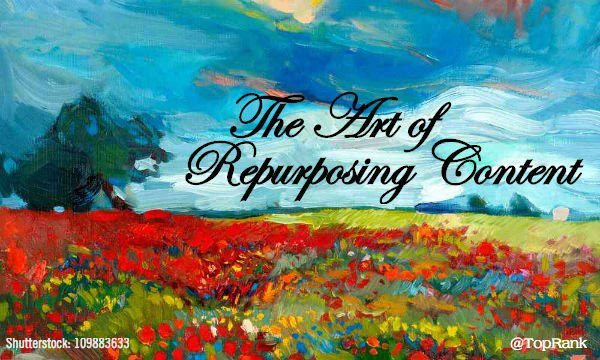
Many companies chasing the “brand publisher” approach to content are running out of steam and troubled by their inability to tie content to marketing ROI.
The most recent B2B content marketing study from from CMI and MarketingProfs shows the biggest challenge with content marketing is measurement (51%) followed by not being able to produce engaging (50%), consistent (44%), or a variety of content (40%).
At the same time, there are numerous B2B content marketing case studies here, here and here of companies succeeding with content marketing programs.
But let’s face it: Even with many success stories (including ours and those of our clients) B2C and B2B Content Marketers alike are challenged. Creating a variety of engaging content on a consistent basis is the bane of many marketing managers world-wide.
What’s the Solution to Content Block in a World of Content Shock?
Like many great solutions to difficult problems, the answer lies in getting creative with how you see solutions.
For example, one person might look at a video, eBook or a report and see a single content object capable of a certain amount of contribution to generating traffic and inquiries. Another person might look at those content objects and see a variety of repurposing options, some duplicative and some personalized for specific audiences in order to increase efficiency as well as relevance.
What I’m talking about here is repurposing content. Repurposing content in a way that creates value works great. In fact, repurposing as a form of personalization for target audiences is even better. But repurposing content solely to increase the number of content objects for promotions, not so great.
How can marketers achieve both operational efficiencies and target audience effectiveness through repurposed content? Through a modular approach.
But before you get into the matrix of modular content planning, I’m going to indulge the overwhelming number of marketers that just want a few repurposing tips to get some extra value out of their current content marketing investments.
The starting point is a documented understanding of your distinct target audience segments. Different groups of people buy your product or service for similar reasons – identify those distinct groups, behaviors and desired solutions.
Here are 5 content repurposing tactics for you to apply to your current marketing to help get you started on the creative path of modular content.
1. Repurposing Basics: Customize and Deconstruct
Identify a key topic that represents what you’re trying to be known for or the solution you provide. Create a substantial resource that provides comprehensive information making your brand the expert. Then figure out, “What does this topic solve for each target audience?”
For example, an eBook about your topic might be structured like this:
- Trend
- Examples
- Case Study
- Best Practices
- Influencer quotes throughout
- Industry statistics throughout
- Tweetables throughout
- Next Steps CTA
How to Repurpose:
- Structure the eBook to be industry specific, so you can create different versions for the distinct industries represented by your target audience segments (Content Marketing for Financial Companies, Content Marketing for SaaS Companies, etc)
- Break the eBook down into component parts according to each target audience. One eBook could be deconstructed into multiple blog posts, infographics, diagrams, presentations, and numerous pieces of micro content – for each distinct industry target.
2. Make Lists
Collect disparate resources relevant to each of your target audiences: statistics, tips, people, events, books, reports, groups, websites, etc. Publish the compiled resources as blog posts. For more attention, evaluate and rank them.
Make the lists recurring at intervals – i.e. serialize your ranked lists of resources monthly, quarterly or annually depending on the amount of new sources being created.
Think of each data element of a list as a building block that can be used individually for things like social shares or as flavor for other content assets from newsletters to blog posts to reports to presentations.
How to Repurpose:
- Aggregate list data elements into in a deck for SlideShare – one for each of your target audiences
- Compile resources into an infographic – customized for each target audience
- Leverage themed list elements for any kind of content you’re producing for a specific target audience – newsletters, white papers, blog posts, contributed articles, emails, ebooks and so on.
3. Capture Live or Recorded Content aka “Liveblgging”
Find events offline or online, live or recorded that contain content and influencers relevant to your target audiences.
Create blog posts for your own site or contributed articles to industry news sites, association websites or vendors in the industry. Summarize strategic, practical, example and case study information specific to a particular industry, application or target audience that is also relevant to your business.
When repurposing, always add new insights and commentary to personalize for your intended audience and to further differentiate content.
How to Repurpose:
- Curate a series of liveblog posts about a topic into a roundup, eBook or visual asset – specific to a target audience
- Pull out quotes as micro content promotable to specific target audiences through social networks
4. Interview Industry Influencers (Famous and Soon to be Famous)
Identify influencers specific to your target audiences and do a series of themed interviews with them. Ask a mix of questions: both strategic and tactical. Make some of the questions within a series the same and designed to evoke practical and tactical answers. Publish the interviews as blog posts, in an eBook or if recorded as videos or podcasts.
How to Repurpose:
- With all interviews, create a library of quotes for social shares specific to a target audience
- Use tips and quotes from the interview in an infographic and in social media friendly images (micro content)
- Leverage all the answers to the repeated questions in a new blog post, presentation, eBook or guide – specific to a target audience
- Curate a series of interviews into a “best of” roundup post specific to a theme, topic or target audience
5. Crowdsource Useful Tips With Your Community
Identify specific questions your buyers have and pose them to your social community. Compile the best answers into a resource – blog post, eBook, presentation, email or infographic. Add your own brand expertise to the crowdsourced tips. When publishing the completed resource, be sure to recognize contributors.
How to Repurpose:
- Cluster answers into industry specific versions of the tips relevant to a particular audience
- Incorporate community generated tips into other content being created for the same industry they are active in
- Recognize your community with content that identifies active contributors – use content they helped create as part of that recognition
As you read through these tips and suggestions, you should be able to see a pattern. It’s about identifying the key interests and pain points for distinct customer segments and then organizing your content in a way that makes it easier to reuse and personalize. That’s a modular content approach.
Whether this post informed you of new repurposing ideas or inspired you to extend ideas you already have, always keep in mind that in order for content be effective, it needs to be useful. Repurposed content that simply duplicates information ala “find and replace” for distribution to a different channel, isn’t really optimized for usefulness.
As long as repurposed content delivers useful information to specific audiences in a way that moves them, inspires them and activates them in their information journey, it’s a win for customers and the brand alike.
Image: Shutterstock


